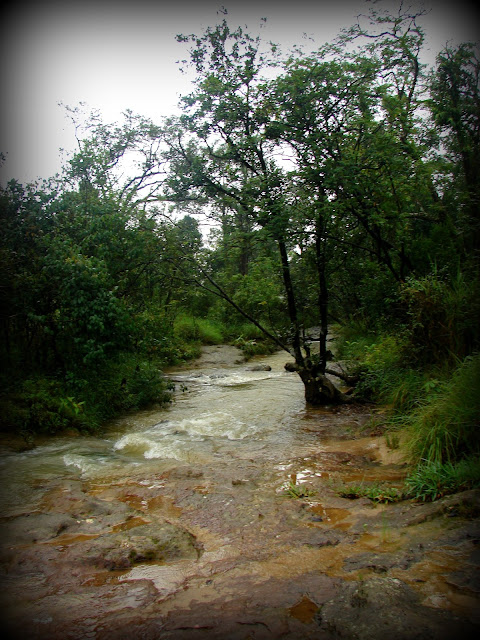 |
| Wari Chora in Garo Hills. Source of photograph: Official Meghalaya Tourism Facebook Page. One can reach Wari Chora from Baghmara. The Wari Chora homestay is about 1.5 hours by road. The trek point is an off-road drive of another 10-15 minutes. The descent trek is about 1-2 hours depending on one's stamina and ability to trek through forests. The ascent back is about 2-3 hours. The canoe ride and exploration at the canoe, waterfall, and river takes about 2-3 hours |
Garo Hills are one of the most unexplored parts of our country. My father tells us stories of his adventurous trips to the beautiful caves and rivers hidden in these hills. The photographs I saw on the Meghalaya Tourism website are absolutely intriguing and I can't wait to visit these mysterious mountains. However, getting the permission to go there will be one big task. Till now my parents did not allow me to venture to that side rather scared me off it. According to them, it's pretty dangerous and unsafe. I googled a bit and yes, this part does sound difficult in terms of infrastructure (but I guess as long as development does not reach there, these hills will remain gorgeous) and insurgencies. People have been abducted and the tribes in these areas can be pretty intimidating for outsiders, I guess (However, I may be wrong since I have been mostly discouraged from traveling to that part of the country). Can't blame them! As has happened in other parts of the world, the tribes were uprooted from their very homeland in the name of development like one of the Khasi groups called Diko are extinct. Guess, it will take a while to figure out how to reach the hidden sanctuaries of these hills before development encroaches on them to mutilate their existence. People have visited and am sure I can as well pretty soon.
 |
| Karukol in Garo Hills. Source of photograph: Official Meghalaya Tourism Facebook Page |
 |
| Simsang River in Garo Hills. Source of photograph: Official Meghalaya Tourism Facebook Page |
 |
| Places of Interest in the Garo Hills |
 |
| The course of the Simsang River. It has its origin in the Nokrek range, then flows down south into Bangladesh where it is called Someshwari |
Origin of the Garos
The origin of Garos is not well documented due to unavailable resources. Garo's history has been passed on through generations orally in the form of stories and legends. Ancient Garo scripts are lost and in recent times, English is their adopted script. The little that has been researched about their origin, suggests that the tribes probably migrated from Tibet. The similarities in language and traditions incline towards the theory. Garo's consider Yak tails sacred which is prevalent in Tibet and regions where Yak's are found. However, Yak is not native to the mountains of Meghalaya or other Garo habitats which further supports the theory, that their ancestral trail must have led to Tibet. Many Garo legends suggest similar stories of their migration from far Northern mountains. Small Garo Villages along the river routes even in the present day, lean towards these migration theories.
Many historians believe different Tibetan tribes migrated to Garo Hills following the course of the Brahmaputra River. Some even detoured toward present-day Sikkim and followed the course of the Teesta River. It is suggested one of the first settlements of Garos was Cooch Behar. They were later driven out from there by the Koch rulers. They moved East to Jogighopa and then to Dalgoma. From Dalgoma they moved South to Garo Hills.
Other historians believe the Tibetan tribes followed the Salween River from its source and moved towards Myanmar. There they followed the course of Chindwin and Irrawaddy Rivers to reach the Mandalay region of Myanmar where they settled down as farmers. Some tribesmen later moved west and crossed over to Dimapur. From Dimapur, some went North towards Northeast Assam and some went towards Garo Hills.
 |
| Probable routes of Garo Migration to Meghalaya from Tibet |
The name Garo was coined by the natives for the migrant tribes. The origin of the name Garo is unknown or rather obscure. Some say stepped farmers were called Gari which later changed to Garo. Some connect the name to Garuda tribes and some connect it to Gara-Ganching tribes. Originally the Garos called themselves Achik Mande which means the hill people. The indigenous Garos were nature worshippers and they followed a religion called Songsarek. In recent times, most Garos have converted to Christianity.
Like the Khasis and Jaintias, the Garos are also matrilineal and matrilocal but not matriarchal. The family name and the property are passed on through a chosen daughter of the family. In the absence of a daughter, a daughter is adopted from the mother's sister's side. After marriage, the groom moves to the bride's family and takes over the responsibilities of the bride's family. The Garos are divided into five exogamous clans called 'chatchis' or 'katchis' - The Marak, The Momin, The Sangma, The Arengh, and The Shira. Each clan is further divided into several septs called 'Machongs'. Marriages are strictly prohibited in the same chatchi. However, in modern times, many just follow marriage prohibition within the same 'machong'. I think the prohibition in marriages within 'chatchi' should have been strictly followed since it prevents inbreeding and recessive genetic mutations in offspring.
There are about 12 sub-tribes of Garos based on their dialects and geographical location: Ambeng/Abeng, A.tong, A.we, Chibok, Chisak, Dual, Gara-Gaching, Koch, Matabeng, Matchi, Matchi-Dual, Megam, and Ruga.
 |
| Distribution of sub-tribes in Garo Hills |
 |
| Shiju Bat Caves - Source of photograph: Official Meghalaya Tourism Facebook Page. One can reach Shiju bird sanctuary and caves from Baghmara in about 1.5 hours drive |
How and when to travel to the Garo hills
I heard from travelers that it is not very easy to get to the caves, waterfalls, and canyons. Most places need a good amount of medium-range trek through deep forests full of leeches, animals, and insects. But I guess that's what makes it an adventurous treasure hunt. I remember trekking to Chitrakote Falls through the deep forests of MP with a tribal guide when it was undiscovered and unexplored. The beauty was exquisite. But now it's an easily accessible tourist spot and always crowded. The interest in the place has since faded. I sincerely feel Garo Hills need to be preserved, and protected and not made easy access!
Garo Hills are one of the wettest places in India, rather entire Meghalaya as the name suggests is the abode of the clouds. Monsoons are a bad time to get here. June and July are an absolute no-no for Meghalaya. Rather June to October is the wettest in the state. People tend to go to the hills for a cooler respite during summer vacations, but if one is planning treks and hiking, summer may not be the best time. It gets a wee bit sweltry. Also, the forests are infested with leeches which gets worse during summers and monsoons. I enjoy winters in Meghalaya and the cool climate makes treks easier. however, if one does not plan treks and hikes, summer may be fine.
Most places of interest in Garo Hills can be reached from Tura and Baghmara. One can reach Tura and Baghmara via Shillong or directly from Guwahati, Assam which has the nearest airport and railway station to the Garo Hills. Nokrek National Park is about 2.5 hours from Tura. Balpakram National Park is around 1.5 hours from Baghmara.




































.jpg)




















